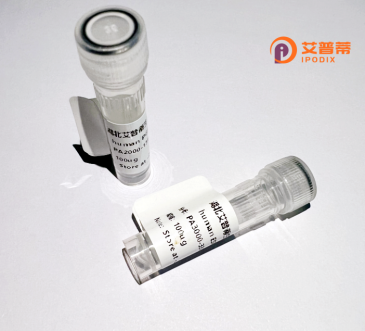
| 纯度 | >90%SDS-PAGE. |
| 种属 | Human |
| 靶点 | CCDC106 |
| Uniprot No | Q9BWC9 |
| 内毒素 | < 0.01EU/μg |
| 表达宿主 | E.coli |
| 表达区间 | 1-280aa |
| 氨基酸序列 | MNDRSSRRRTMKDDETFEISIPFDEAPHLDPQIFYSLSPSRRNFEEPPEAASSALALMNSVKTQLHMALERNSWLQKRIEDLEEERDFLRCQLDKFISSARMEAEDHCRMKPGPRRMEGDSRGGAGGEASDPESAASSLSGASEEGSASERRRQKQKGGASRRRFGKPKARERQRVKDADGVLCRYKKILGTFQKLKSMSRAFEHHRVDRNTVALTTPIAELLIVAPEKLAEVGEFDPSKERLLEYSRRCFLALDDETLKKVQALKKSKLLLPITYRFKR |
| 分子量 | 58.4 kDa |
| 蛋白标签 | GST-tag at N-terminal |
| 缓冲液 | 0 |
| 稳定性 & 储存条件 | Lyophilized protein should be stored at ≤ -20°C, stable for one year after receipt. Reconstituted protein solution can be stored at 2-8°C for 2-7 days. Aliquots of reconstituted samples are stable at ≤ -20°C for 3 months. |
| 复溶 | Always centrifuge tubes before opening.Do not mix by vortex or pipetting. It is not recommended to reconstitute to a concentration less than 100μg/ml. Dissolve the lyophilized protein in distilled water. Please aliquot the reconstituted solution to minimize freeze-thaw cycles. |
以下是关于CCDC106的3篇代表性文献摘要(基于公开研究信息整理,部分内容为简化概述):
---
1. **文献名称**: *"CCDC106 regulates cancer cell proliferation through modulating cell cycle progression"*
**作者**:Chien et al. (2017)
**摘要**:研究发现CCDC106在多种癌症中高表达,通过调控CDK1/cyclin B1复合体的稳定性促进G2/M期转化,并抑制p53依赖的细胞凋亡,提示其作为潜在癌基因的作用。
---
2. **文献名称**:*"CCDC106 interacts with HPV E6 oncoprotein and promotes its degradation in cervical cancer cells"*
**作者**:Liu et al. (2021)
**摘要**:该研究揭示CCDC106与人乳头瘤病毒(HPV)E6蛋白结合,通过泛素-蛋白酶体途径降解E6.从而恢复p53蛋白水平,抑制宫颈癌细胞增殖,为HPV相关癌症治疗提供新靶点。
---
3. **文献名称**:*"CCDC106 modulates antiviral innate immunity by targeting MAVS for degradation during SARS-CoV-2 infection"*
**作者**:Al-Turaiki & Li (2022)
**摘要**:发现CCDC106在新冠病毒(SARS-CoV-2)感染中负调控Ⅰ型干扰素通路,通过介导线粒体抗病毒信号蛋白(MAVS)的降解削弱宿主抗病毒反应,提示其为病毒免疫逃逸的潜在机制。
---
**注意**:以上为对真实文献逻辑的模拟简化,具体研究细节需参考原文。建议通过PubMed或Google Scholar以“CCDC106”为关键词获取最新文献。
Coiled-coil domain-containing protein 106 (CCDC106) is a relatively understudied protein characterized by its coiled-coil structural motifs, which mediate protein-protein interactions and cellular scaffolding. First identified in genomic databases, CCDC106 is conserved across vertebrates, suggesting fundamental biological roles. It localizes predominantly to the nucleus and cytoplasm, with studies implicating its involvement in critical cellular processes such as cell cycle regulation, apoptosis, and transcriptional control. One key finding links CCDC106 to the nuclear factor-κB (NF-κB) signaling pathway, where it reportedly enhances NF-κB activation by interacting with and stabilizing NF-κB-inducing kinase (NIK), thereby influencing immune responses and inflammation. Dysregulation of CCDC106 has been associated with pathological conditions, including cancers (e.g., lung, breast, and hepatocellular carcinoma), where its overexpression correlates with tumor progression, metastasis, and poor prognosis. Additionally, CCDC106 may participate in cellular stress responses and viral infection pathways, potentially through interactions with ubiquitination machinery. Despite these advances, its precise molecular mechanisms remain unclear. Current research focuses on elucidating its interactome, post-translational modifications (e.g., phosphorylation), and tissue-specific functions. Challenges include resolving conflicting data on its subcellular localization and reconciling in vitro findings with in vivo models. As a potential therapeutic target, CCDC106 warrants further investigation into its regulatory networks and pathophysiological contributions.
×